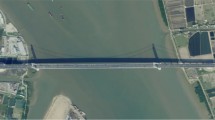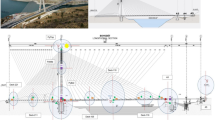Abstract
The effect of structural changes on the temperature behavior of a long-span bridge pylon was examined using field-measured data and finite element (FE) analysis. Temperature behavior of the pylon could be modeled using two characteristic parameters, α and β, which reflect the influence of the variation in the ambient temperature and the sectional temperature difference, respectively. Two major structural changes namely, decrease in stiffness in the lower region of the pylon and decrease in area of the main cable were considered in the FE analyses, which showed that both α and β were affected by the structural changes. Furthermore, the two characteristic parameters could be extracted with sufficient accuracy from field-measured temperatures and tilting angle data using a system-identification technique. Consequently, the feasibility of identification of structural changes by continuous observation of temperature parameters was demonstrated. However, the tilting angle of the pylon is influenced by other loads than the temperature and therefore future studies on eliminating other loading effects (such as that owing to wind or traffic) are necessary.

















Similar content being viewed by others
References
Cao, Y., Yim, J., Zhao, Yang, & Wang, M. L. (2010). Temperature effects on cable stayed bridge using health monitoring system: A case study. Structural Health Monitoring: An International Journal,10(5), 523–537.
Chang, S. P., Kim, S., Lee, J., & Bae, I. (2008). Health monitoring system of a self-anchored suspension bridge (planning, design and installation/operation). Structure and Infrastructure Engineering,4(3), 193–205.
Chang, S. P., Yee, J., & Lee, J. (2009). Necessity of the bridge health monitoring system to mitigate natural and man-made disasters. Structure and Infrastructure Engineering,5(3), 173–197.
Fu, Y., & DeWolf, J. T. (2004). Effect of differential temperature on a curved post-tensioned concrete bridge. Advances in Structural Engineering,7(5), 385–397.
Kim, H. K., Kim, N. S., Jang, J. H., & Kim, Y. H. (2012). Analysis model verification of a suspension bridge exploiting configuration survey and field-measured data. Journal of Bridge Engineering,17(5), 794–803.
Kim, S., Kim, C. Y., & Lee, J. (2005). Monitoring results of a self-anchored suspension bridge. In F. Ansari (Ed.), Sensing issues in civil structural health monitoring (pp. 475–484). Dordrecht: Springer.
Koh, H. M., Kim, S., & Choo, J. F. (2005). Recent development of bridge health monitoring system in Korea. In F. Ansari (Ed.), Sensing issues in civil structural health monitoring (pp. 33–42). Dordrecht: Springer.
Koo, K. Y., Brounjohn, J. M. W., List, D. I., & Cole, R. (2013). Structural health monitoring of the Tamar suspension bridge. Structural Control and Health Monitoring,20, 609–625.
Liu, H., Chen, Z., & Zhou, T. (2013). Investigation on temperature distribution and thermal behavior of large span steel structures considering solar radiation. Advanced Steel Construction,9(1), 41–58. https://doi.org/10.18057/ijasc.2013.9.1.4.
Lynch, J. P., & Loh, K. J. (2006). A summary review of wireless sensors and sensor networks for structural health monitoring. The Shock and Vibration Digest,38(2), 91–128.
Magalhaes, F., Cunha, A., & Caetano, E. (2012). Vibration based structural health monitoring of an arch bridge: From automated OMA to damage detection. Mechanical Systems and Signal Processing,28, 212–228.
MIDAS Information Technology (MIDAS IT). (1996). Midas civil-integrated solution system for bridge and civil structures. MIDAS Information Technology, http://www.MidasUser.com
Ou, J., & Li, H. (2010). Structural health monitoring in mainland China: Review and future trends. Structural Health Monitoring,9(3), 213–219.
Park, G., Kabeya, K., Cudney, H. H., & Inman, D. J. (1999). Impedance-based structural health monitoring for temperature varying application. JSME International Journal, Series A,42(2), 249–258.
Park, G., Sohn, H., Farrar, C. R., & Inman, D. J. (2003). Overview of piezoelectric impedance-based health monitoring and path forward. The Shock and Vibration Digest,35(6), 451–463.
Roberts-Wollman, C. L., Breen, J. E., & Cawrse, J. (2002). Measurements of thermal gradients and their effects on segmental concrete bridge. Journal of Bridge Engineering (ASCE),7(3), 166–174.
Sohn, H., Dzwonczyk, M., Straser, E. G., Kiremidjian, A. S., Law, K. H., & Meng, T. (1999). An experimental study of temperature effect on modal parameters of the Alamosa Canyon Bridge. Earthquake Engineering and Structural Dynamics,28, 879–897.
Wong, K. Y. (2004). Instrumentation and health monitoring of cable-supported bridges. Structural Control and Health Monitoring,11, 91–124.
Xia, Y., Chen, B., Zhou, X. Q., & Xu, Y. L. (2013). Field monitoring and numerical analysis of Tsing Ma Suspension Bridge temperature behavior. Structural Control and Health Monitoring,20, 560–575.
Xu, Y. L., Chen, B., Ng, C. L., Wong, K. Y., & Chan, W. Y. (2010). Monitoring temperature effect on a long suspension bridge. Structural Control and Health Monitoring,17, 632–653. https://doi.org/10.1002/stc.340.
Yarnold, M. T., & Moon, F. L. (2015). Temperature-based structural health monitoring baseline for long-span bridges. Engineering Structures,86, 157–167.
Zhao, Z., Liu, H., & Chen, Z. (2017a). Field monitoring and numerical analysis of thermal behavior of large span steel structures under solar radiation. Advanced Steel Construction,13(3), 190–205. https://doi.org/10.18057/ijasc.2017.13.3.1.
Zhao, Z., Liu, H., & Chen, Z. (2017b). Thermal behavior of large-span reticulated domes covered by ETFE membrane roofs under solar radiation. Thin-Walled Structures,115, 1–11.
Acknowledgements
The present research was conducted by the research fund of Dankook University in 2017. The authors are very grateful for the cooperation of the Busan Infrastructure Corporation (BISCO).
Author information
Authors and Affiliations
Corresponding author
Additional information
Publisher's Note
Springer Nature remains neutral with regard to jurisdictional claims in published maps and institutional affiliations.
Rights and permissions
About this article
Cite this article
Lee, J., Loh, K.J., Choi, H.S. et al. Effect of Structural Change on Temperature Behavior of a Long-Span Suspension Bridge Pylon. Int J Steel Struct 19, 2073–2089 (2019). https://doi.org/10.1007/s13296-019-00279-3
Received:
Accepted:
Published:
Issue Date:
DOI: https://doi.org/10.1007/s13296-019-00279-3




